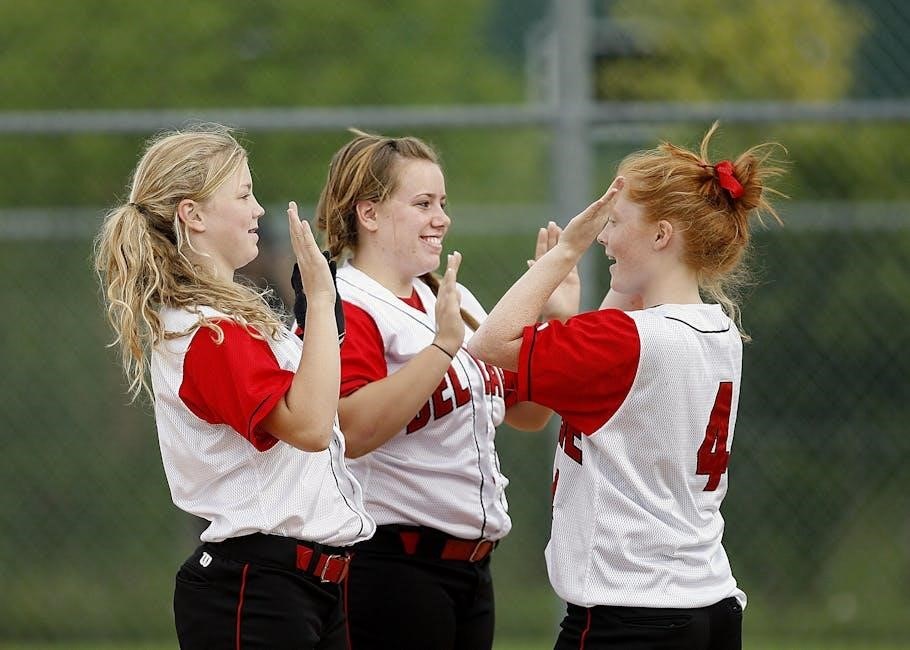Softball defensive situations require strategic positioning, adaptability, and clear communication. Understanding the fundamentals, such as infield and outfield responsibilities, is crucial for making effective plays. Preparation and teamwork ensure players anticipate and react to various game scenarios, including bunts, double plays, and runner interference. Mastering these elements enhances overall defensive performance and contributes to the team’s success.
1.1 Understanding the Basics of Softball Defense
Softball defense begins with understanding fundamental positions and roles; Infielders, including the pitcher, catcher, and infield players, focus on fielding ground balls and making quick decisions. Outfielders cover larger areas, tracking fly balls and supporting infield plays. Basic skills like fielding, throwing, and catching are essential. Communication and awareness of game situations help players anticipate and react effectively, forming the foundation of a solid defensive strategy.
1.2 Importance of Preparation and Adaptability
Preparation and adaptability are vital in softball defense. Teams must anticipate various scenarios, such as bunts, steals, and aggressive base running. Drills and practice build muscle memory and quick decision-making skills. Adaptability allows players to adjust strategies based on the game’s progression, ensuring they remain effective in high-pressure situations. Flexibility enhances overall defensive performance and contributes to the team’s ability to secure outs and prevent scoring opportunities.
Fundamental Defensive Positioning
Proper positioning of infield and outfield players is essential for effective defense; Each position has specific responsibilities and alignment to maximize defensive coverage and support.
2.1 Infield Positions and Responsibilities
The infield positions in softball include the pitcher, catcher, first baseman, second baseman, third baseman, and shortstop. Each player has specific responsibilities, such as fielding ground balls, covering bases, and making accurate throws. The shortstop and second baseman often work together to turn double plays, while the third baseman handles bunts and line drives. Proper positioning and communication among infielders are key to executing defensive strategies effectively.
2.2 Outfield Positions and Coverage Areas
The outfield consists of three positions: left fielder, center fielder, and right fielder. Each outfielder is responsible for covering a specific area of the field, tracking fly balls, and backing up infielders. The center fielder often serves as the leader, directing other outfielders. Outfielders must communicate effectively, use verbal cues, and ensure proper alignment to prevent gaps in coverage and minimize extra bases for opposing teams.

Communication in Defensive Situations
Effective communication is vital in softball defense. Verbal cues and hand signals ensure alignment and strategy. Pre-pitch discussions clarify roles, while adaptability allows adjustments during plays, enhancing teamwork.
3.1 Pre-Pitch Communication and Signals
Pre-pitch communication is crucial for aligning defensive strategies. Signals convey the defensive plan, ensuring all players understand their roles. The catcher often coordinates with infielders, discussing bunt defense and positioning based on the batter. Verbal cues and hand signals clarify expectations, preventing miscommunication. This preparation enables the team to anticipate plays effectively, ensuring cohesive execution during the game and enhancing overall defensive performance.
3.2 Calling Off Plays and Adjustments
Calling off plays and making adjustments is essential for dynamic defensive strategies. Players must communicate clearly to avoid collisions or confusion. The infielders and outfielders rely on verbal calls to prioritize catches or fielding decisions. Adjustments are made based on the game’s progression, such as shifting positions or altering pitch outs, to counter offensive tactics and maintain defensive control throughout the game effectively.
Common Defensive Plays and Strategies
Common defensive plays include bunt defense, double plays, and pitch outs. These strategies are executed to outsmart opponents and secure outs effectively during gameplay situations.
4.1 Bunt Defense and Fielding Techniques
Bunt defense requires strategic positioning and quick reactions. Fielders must anticipate the bunt, communicate effectively, and execute precise throws. Proper footwork and glove work are essential for cleanly fielding bunts. Teams often employ specific alignments to counter bunt attempts, ensuring outs and minimizing opponent advancements. Effective bunt defense can significantly impact game outcomes by preventing scoring opportunities.
4.2 Double Plays and Force Outs
Double plays and force outs are critical defensive strategies to quickly record outs. They often involve infielders making sharp turns or quick throws to bases. Force outs rely on baserunners being compelled to advance, while double plays require precise execution to retire two runners. These plays disrupt offensive momentum and are vital for preventing runs, especially in high-pressure situations.
4.3 Pitch Outs and Intentional Walks
Pitch outs and intentional walks are strategic defensive tactics. Pitch outs disrupt base stealers by throwing to the base before the batter hits. Intentional walks avoid potent hitters, putting a runner on base to set up double plays. These moves require coordination between pitchers and catchers, balancing risk and reward to control the game’s flow and minimize offensive threats effectively.
Situational Defense and Decision-Making
Situational defense involves adjusting strategies based on the game’s context, such as score, inning, and runner positions. Smart decisions maximize defensive efficiency and control the game’s momentum.
5.1 Score-Based Defensive Adjustments
Score-based defensive adjustments involve strategically positioning players according to the game’s score. With a lead, defenses may play deeper to prevent big innings. When trailing, infielders may play up to prevent ground-ball hits. Pitchers adjust their strategy, throwing more off-speed pitches to conserve runs. Outfielders shift positions to defend against potential game-tying hits, ensuring optimal coverage based on the score.
5.2 Inning-Specific Strategies
Inning-specific strategies involve tailoring defensive approaches based on the game’s progression. Early innings focus on reading the opponent’s strengths and adjusting positioning. Middle innings may require shifting defenders based on observed tendencies. Late innings often involve more aggressive plays, such as holding runners and preventing advances. Teams adapt their pitching and fielding strategies to match the inning’s demands, ensuring flexibility and proactive defense throughout the game.

Defensive Situations with Runners on Base
Defensive situations with runners on base demand quick decisions and precise execution. Fielders must communicate effectively, position strategically, and anticipate potential plays to prevent advances and minimize scoring opportunities.
Understanding runner tendencies and reacting swiftly is critical in these high-pressure scenarios.
6.1 Runner on Third Base Scenarios
A runner on third base presents critical defensive challenges. The defense must communicated effectively, ensuring the pitcher and catcher coordinate pitch selection to prevent scoring opportunities. Infielders should position themselves strategically for potential bunts or ground balls, while outfielders remain alert for relay throws. Quick reactions and precise throws are essential to prevent the runner from scoring, especially with fewer than two outs in the inning.
6.2 Runner Interference Rules and Applications
Runner interference occurs when a baserunner intentionally hinders a defensive player attempting to make a play. If interference is called, the runner is out, and the ball is dead. This rule applies when a runner deflects a batted or thrown ball or obstructs a fielder’s movement. Proper application of this rule ensures fair play and protects defensive players from unnecessary contact or obstruction during game situations.

Pitching and Defensive Coordination
Pitching and defensive coordination involve strategic pitch selection and alignment based on game situations. This synergy ensures the defense is positioned to effectively execute plays and limit offensive opportunities.
7.1 Pitch Selection Based on Defensive Alignment
Pitch selection is crucial and often dictated by the defensive alignment. Positioning fielders strategically based on the batter’s tendencies allows pitchers to throw pitches that increase the likelihood of weak contact or ground balls. For instance, pitching inside to pull-heavy hitters can lead to ground outs to the left side of the infield, where defenders are positioned. This coordination maximizes defensive effectiveness and limits offensive opportunities, showcasing the importance of a well-executed game plan.
7.2 Pitcher-Catcher Communication
Effective communication between the pitcher and catcher is vital for executing defensive strategies. The catcher typically calls pitches based on the batter’s strengths and the defensive alignment. Clear signals ensure the pitcher understands the desired pitch type and location. This coordination disrupts the batter’s timing and complements the infield and outfield positioning, creating a unified defensive approach to minimize offensive success and control the game’s tempo effectively.
Cutoff Plays and Relays
Cutoff plays and relays are critical for preventing runners from advancing. They require precise communication and quick decision-making to stop runners and limit offensive scoring opportunities effectively.
8.1 Executing Effective Cutoffs
Effective cutoffs require precise positioning and quick decision-making. Fielders must intercept throws from outfielders, preventing runners from advancing. Communication before the pitch ensures alignment with the outfielder’s throw. Cutoffs are adjusted based on the game situation, such as the number of outs or runner speed. Proper execution prevents extra bases and maintains defensive control, showcasing teamwork and situational awareness.
8.2 Relay Throws to Prevent Advances
Relay throws are critical for stopping runners from advancing. Infielders must position themselves to receive outfield throws accurately. Quick, sharp throws to the appropriate base are essential. Communication ensures the relay is executed smoothly, with all players aware of their roles. Proper footwork and throwing mechanics prevent errors, maintaining defensive integrity and limiting offensive opportunities effectively in game situations.
Defensive Strategies in Late-Game Situations
Late-game defense requires focused strategies, such as managing the score, leveraging pitcher-catcher coordination, and maintaining calm under pressure to secure outs and protect leads effectively.
9.1 Managing the Last Inning
Managing the last inning demands precision and focus. Defenders must anticipate bunts, secure force outs, and maintain strong infield and outfield positioning to prevent runners from advancing. Effective communication between the pitcher and catcher is crucial to execute pitches that minimize scoring opportunities. Staying calm under pressure ensures the team can close the game with confidence and secure the victory.
9.2 High-Pressure Defensive Scenarios
High-pressure defensive scenarios, such as tie games or bases loaded, demand quick decision-making and sharp execution. Defenders must stay focused, communicate clearly, and anticipate potential plays. Securing force outs, fielding bunts cleanly, and making accurate throws are critical. Trusting the game plan and relying on teamwork helps maintain composure under stress, ensuring the defense can make game-saving plays when it matters most.
Special Defensive Situations
Special defensive situations, like bunts and aggressive base running, require tailored strategies. Teams must adapt quickly, coordinating pitching and fielding to outsmart opponents and secure critical outs effectively.
10.1 Handling Bunt and Slash Situations
Handling bunt and slash situations demands quick reactions and strategic positioning. Teams must communicate effectively pre-pitch to set up defenses, anticipating sacrifice or drag bunts. Slash situations, combining bunts with base stealing, require infielders to balance coverage of the bunt and potential steals. Pitch selection and infield depth can be adjusted to counter these tactics, ensuring the defense remains one step ahead of the offense.
10.2 Defending Against Aggressive Base Running
Defending against aggressive base running requires a balanced approach, combining smart positioning and quick decision-making. Teams should anticipate potential steals by setting up pitchouts and holding runners close. Effective communication between the pitcher and catcher is key to disrupting stolen base attempts. Additionally, cutoff plays and relay throws must be executed flawlessly to prevent extra bases and limit the offense’s scoring opportunities effectively.
Defensive Drills for Practice
Drills should focus on improving fielding, throwing accuracy, and reaction time. Incorporate scenarios simulating game situations to enhance decision-making and teamwork, ensuring players are prepared for any defensive challenge.
11.1 Infield and Outfield Drill Exercises
Infield drills focus on ground ball repetitions, double-play turns, and bunt fielding. Outfield exercises emphasize tracking fly balls, relay throws, and accurate cutoffs. Drills should simulate game situations, such as runners on base or bunt attempts, to improve reaction time and decision-making. Varying drills by skill level ensures players build confidence and mastery of defensive skills, enhancing overall team performance and readiness for competitive play.
11.2 Situational Scenarios in Practice
Practices should include situational drills like bunt defense, base runners, and double plays. Simulate game-like scenarios to improve decision-making and reaction time. Players practice fielding grounders with runners on base and executing relay throws. These exercises help build instincts and confidence, ensuring players are prepared for any defensive situation during a game, from routine plays to high-pressure moments.

Review of Key Defensive Concepts
Reviewing defensive fundamentals ensures consistency and effectiveness. Focus on proper positioning, clear communication, and strategic decision-making. Analyzing common mistakes and reinforcing techniques improves overall team performance and adaptability.
12.1 Reinforcing Proper Techniques
Reinforcing proper techniques ensures consistency and effectiveness in defensive play. Regular drills and practice focus on fielding, throwing, and positioning. Emphasizing footwork and glove work enhances infield and outfield performance. Coaches provide targeted feedback to address weaknesses, helping players master skills like double plays and cutoffs. Correcting errors and building confidence are key to a strong defense.
12.2 Analyzing Common Defensive Mistakes
Common defensive mistakes often stem from poor communication or misjudging fly balls. Infielders may misplay grounders due to improper footwork, while outfielders might misread ball trajectories. Overthrowing cutoffs can lead to extra bases. Coaches review game footage to identify these errors, providing insights for improvement. Addressing these mistakes through drills and practice strengthens the team’s overall defensive reliability and performance.
Mastering softball defensive situations requires continuous improvement, preparation, and teamwork. By understanding strategies and correcting common mistakes, players enhance their skills, ensuring a strong, cohesive defense.
13.1 Summarizing Effective Defensive Strategies
Effective defensive strategies in softball involve proper positioning, clear communication, and adaptability. Teams must prepare for various situations, such as bunts, double plays, and runner interference. Understanding when to force outs or tag runners is critical. Practicing drills and reviewing common mistakes helps refine techniques. By mastering these strategies, players can anticipate plays, reduce errors, and maintain a strong defensive presence throughout the game.
13.2 Encouraging Continuous Improvement
Continuous improvement in softball defense involves consistent practice, game analysis, and a growth mindset. Players should review past performances, identify weaknesses, and refine techniques through targeted drills. Coaches can provide constructive feedback and encourage teamwork. Staying adaptable and focused ensures steady progress. By embracing challenges and learning from mistakes, teams can elevate their defensive skills and achieve long-term success in competitive play.



0 Comments